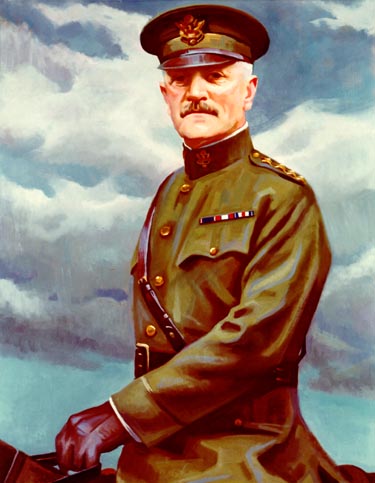
John Joseph Pershing was born near Laclede, Missouri, on 13 September 1860; attended the State Normal School, then graduated from the United States Military Academy, 1886; was commissioned a second lieutenant and assigned to the 6th Cavalry, July 1886; performed garrison and field duties in the Southwest and Northern Plains, 1886–1890, and participated in the Wounded Knee campaign; was professor of military science and tactics at University of Nebraska, 1891–1895, studying law concurrently and receiving his degree, 1893; was promoted to first lieutenant and assigned to the 10th Cavalry, October 1892; served in Montana, 1895–1896; after a brief tour at Army headquarters, was assistant instructor in tactics at West Point, 1897–1898; served with the 10th in Cuba, including operations at San Juan Hill; was promoted to major of volunteers, detailed in ordnance, and assigned to Army headquarters and the Office of the Assistant Secretary of War, 1898–1899, where he organized a Bureau of Insular Affairs; was reverted to a regular captaincy, June 1901, and assigned successively to the 1st and 10th Cavalry; served in the Philippines as a departmental adjutant general and engineer officer, collector of customs, and cavalry squadron commander, participating in actions against Moros, 1899–1903; served on the War Department General Staff, 1903–1904, and as assistant chief of staff of the Southwestern Division, 1904; attended the Army War College, 1904–1905; married Frances Warren, 1905; was military attaché to Japan and an observer of the Russo-Japanese War, 1905–1906; at President Roosevelt’s nomination, was promoted to brigadier general over 862 senior-ranking officers, September 1906; commanded the Department of California, 1906, and Fort McKinley, 1907–1908; was assigned to the Office of the Chief of Staff, 1908–1909; was governor of Moro Province and commander, Department of Mindanao, 1909–1913; commanded the 8th Infantry Brigade at the Presidio of San Francisco, 1914–1916, where in 1915 he lost his wife and three daughters in a fire; led the Mexican Punitive Expedition, 1916–1917, receiving promotion to major general during the campaign; was promoted to general, October 1917; commanded the American Expeditionary Forces in France in World War I, 1917–1919; was advanced to the rank of General of the Armies, September 1919; moved his headquarters to Washington, prepared a report on the war, and made an extended tour of military inspection, 1919–1921; was chief of staff of the United States Army, 1 July 1921–13 September 1924; established the War Plans Board; pressed for national preparedness, a strong Army, increased efficiency and economy, officer schooling, and a well-regulated militia; retired from active service, September 1924; was chairman of the American Battle Monuments Commission, 1923–1948, and headed the Tacna-Arica Boundary Commission, 1925–1926; died in Washington, D.C., on 15 July 1948.
The Artist
Richard Leopold Seyffert (1915–1979), son of the renowned portraitist Leopold Seyffert, was born in Philadelphia, received his formal schooling in Switzerland and then studied with Leon Kroll and Gifford Beal at the National Academy of Design in New York City. He continued his studies in Italy before embarking upon his professional career in Chicago at the end of the 1930s. During World War II he served in the Navy as a photographer’s mate, then spent three postwar years in Peru painting prominent personalities in the diplomatic and social worlds. He established his studio in New York City in 1950, going on to paint such notable figures as W. K. Kellogg, Edward R. Murrow, Fannie Hurst, W. H. Auden, and Richard Rogers.
John Joseph Pershing
By Richard Leopold Seyffert
Oil on canvas, 36" x 30", 1975
[110]

[111]
page updated 30 April 2001